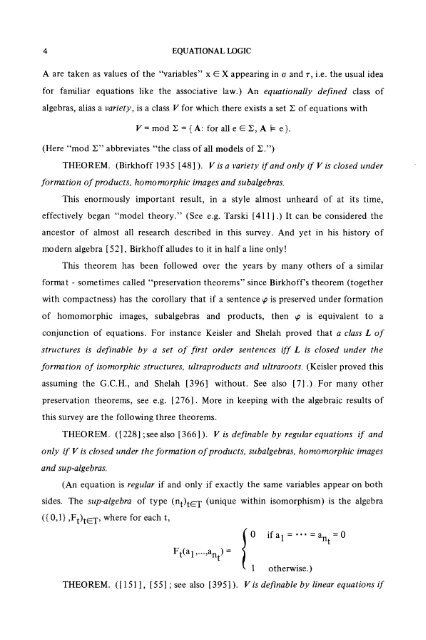Survey 1979: Equational Logic - Department of Mathematics ...
Survey 1979: Equational Logic - Department of Mathematics ...
Survey 1979: Equational Logic - Department of Mathematics ...
Create successful ePaper yourself
Turn your PDF publications into a flip-book with our unique Google optimized e-Paper software.
4 EQUATIONAL LOGIC<br />
A are taken as values <strong>of</strong> the "variables" x C X appearing in o and r, i.e. the usual idea<br />
for familiar equations like the associative law.) An equationally defined class <strong>of</strong><br />
algebras, alias a variety, is a class V for which there exists a set Z <strong>of</strong> equations with<br />
V=mod23=(A: for alleC23, A e).<br />
(Here "mod 23" abbreviates "the class <strong>of</strong> all models <strong>of</strong> 23.")<br />
THEOREM. (Birkh<strong>of</strong>f 1935 [48] ). V is a variety if and only if V is closed under<br />
formation <strong>of</strong> products, homomorphic images and subalgebras.<br />
This enormously important result, in a style almost unheard <strong>of</strong> at its time,<br />
effectively began "model theory." (See e.g. Tarski [41 1].) It can be considered the<br />
ancestor <strong>of</strong> almost all research described in this survey. And yet in his history <strong>of</strong><br />
modern algebra [52], Birkh<strong>of</strong>f alludes to it in half a line only!<br />
This theorem has been followed over the years by many others <strong>of</strong> a similar<br />
format - sometimes called "preservation theorems" since Birkh<strong>of</strong>f's theorem (together<br />
with compactness) has the corollary that if a sentence 0 is preserved under formation<br />
<strong>of</strong> homomorphic images, subalgebras and products, then 0 is equivalent to a<br />
conjunction <strong>of</strong> equations. For instance Keisler and Shelah proved that a class L <strong>of</strong><br />
structures is definable by a set <strong>of</strong> first order sentences iff L is closed under the<br />
formation <strong>of</strong> isomorphic structures, ultraproducts and ultraroots. (Keisler proved this<br />
assuming the G.C.H., and Shelah [396] without. See also [7].) For many other<br />
preservation theorems, see e.g. [276]. More in keeping with the algebraic results <strong>of</strong><br />
this survey are the following three theorems.<br />
THEOREM. ([228] ;see also [366]). V is definable by regular equations if and<br />
only if V is closed under the formation <strong>of</strong> products, subalgebras, homomorphic images<br />
and sup-algebras.<br />
(An equation is regular if and only if exactly the same variables appear on both<br />
sides. The sup-algebra <strong>of</strong> type (nt)tC T (unique within isomorphism) is the algebra<br />
({ 0,1) ,Ft)tGT, where for each t,<br />
Ft(a 1 ,...,ant) =<br />
0 if al an t<br />
1 otherwise.)<br />
THEOREM. ([ 151 ], [55]; see also [395] ). V is definable by linear equations if

















